
This lesson was created for use in the Business and Personal Law Classroom to teach criminal law.
- Subject:
- Education
- General Law
- Law
- Material Type:
- Activity/Lab
- Lesson
- Lesson Plan
- Date Added:
- 07/10/2019

This lesson was created for use in the Business and Personal Law Classroom to teach criminal law.

Hosmanek, Smith, and Dayton
Word Count: 121261
(Note: This resource's metadata has been created automatically by reformatting and/or combining the information that the author initially provided as part of a bulk import process.)
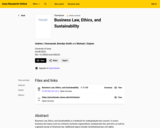
Business Law, Ethics, and Sustainability is a textbook for undergraduate law courses. It covers business law topics such as contracts, business organizations, employment law, and torts, as well as a general survey of American law. Additional topics include Constitutional law, civil rights, environmental law, criminal law, and litigation.
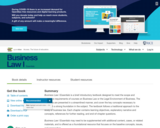
Business Law I Essentials is a brief introductory textbook designed to meet the scope and sequence requirements of courses on Business Law or the Legal Environment of Business. The concepts are presented in a streamlined manner, and cover the key concepts necessary to establish a strong foundation in the subject. The textbook follows a traditional approach to the study of business law. Each chapter contains learning objectives, explanatory narrative and concepts, references for further reading, and end-of-chapter questions.
Business Law I Essentials may need to be supplemented with additional content, cases, or related materials, and is offered as a foundational resource that focuses on the baseline concepts, issues, and approaches.

Provides context and essential concepts across the entire range of legal issues with which managers and business executives must grapple. The text provides the vocabulary and legal acumen necessary for business people to talk in an educated way to their customers, employees, suppliers, government officials—and to their own lawyers.
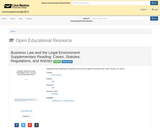
Supplementary Readings for Business Law and the Legal Environment (Ed. Keith Tierney, rev. 2019).
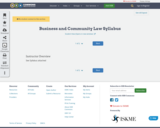
See Syllabus attached

This policy will help the students feel safe and secured in the online classroom setting.
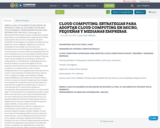
DEBIDO A QUE ACTUALMENTE SE ENCUENTRA EN REVISIÓN LA TESIS, EL DOCUMENTO ES PRIVADO POR EL MOMENTO,
PRÓXIMAMENTE SE DARÁ MAS INFORMACIÓN. GRACIAS.
La Tecnología de la Información (TI) siempre ha sido considerada un punto importante en las organizaciones empresariales, desde la perspectiva de los costos y de gestión. Es parte integral de la tecnología y los modelos de negocio de las empresas y las ha obligado a adaptarse a las nuevas estrategias de tecnología. Con los avances de infraestructura en la tecnología de la información y la comunicación, los nuevos modos de programación y los nuevos modelos en su uso; han llegado también nuevas formas de denominar los servicios de Internet. Factores como la mercantilización de hardware, software de código abierto, la virtualización, la globalización de la fuerza de trabajo y los procesos ágiles de TI han apoyado el desarrollo de nuevos modelos de tecnología y negocios. La computación en nube o Cloud Computing ofrece a las organizaciones más opciones en cuanto a cómo gestionar las infraestructuras, ahorrar costes, trabajar en equipo remotamente y delegar responsabilidades a proveedores de servicios Cloud o terceros, sin que los usuarios tengan que tener ningún conocimiento de la infraestructura que hay detrás.
La mayoría de las empresas se esfuerzan por reducir su coste del área de TI a través de los medios de virtualización. Esta demanda de reducir el costo ha dado lugar a la innovación de la computación en nube, ya que ofrece una reducción en los costos de administración así como reducción de costos de infraestructura. Los grandes beneficios del Cloud Computing permiten la adquisición de recursos computacionales de manera rápida, flexible y con un menor costo de implementación para los usuarios o empresas y es rentable para los proveedores, pues a pesar de presentar algunos riesgos, el poder trabajar con este nuevo tipo de tecnología permite al usuario ahorrarse tanto licencias, como la administración de servicios y de los equipos necesarios. Además de beneficios en términos de costo, el Cloud Computing puede presentar beneficios de seguridad ya que brinda a las empresas normas y estándares de seguridad de los más altos niveles internacionales. Incluso presenta beneficios ambientales y sociales. Todo gracias a la arquitectura conformada por los modelos con los cuales trabaja el Cloud Computing, denominadas por sus siglas: SaaS, PaaS e IaaS, las cuales corresponden al software, plataforma e infraestructura como servicios respectivamente.
El Cloud Computing se encuentra todavía en una etapa infantil y es una nueva tecnología para las micro, pequeñas, medianas o nuevas empresas. Existen pocas guías y marcos para una óptima adopción, la mayoría de ellos no se encuentran en la lengua española o no engloban todos los factores y cuestiones necesarias para generar confianza en esta tecnología. Por lo tanto, la mayoría de las empresas no están muy seguras en adoptar la tecnología. La presente tesis aborda el problema de confianza en la adopción y se discuten y analizan las barreras que se pueden presentar al adoptar la computación en nube en una empresa. Se presentan una serie de estrategias, una hoja de ruta y un marco que servirán como una guía para enfrentar los desafíos, cuestiones o factores en términos de costo, seguridad, confidencialidad, confianza, cumplimiento normativo, cumplimiento legal y cumplimento-TI, así como los factores organizacionales/humanos. En esta tesis se detallan exhaustivamente todos los temas referentes al Cloud Computing desde sus antecedentes, evolución, arquitectura, tecnología, modelos de negocio, modelos de servicio, modelos de despliegue, proveedores del servicio, etc. y así se logre un profundo entendimiento del paradigma de computación en nube. La metodología fue realizada siguiendo los lineamientos de diferentes estándares, normas, protocolos, estándares, certificados y mejores prácticas internacionalmente reconocidas respecto a la seguridad de la información en un entorno de TI ó enfocadas a entornos de Cloud Computing como: ISO/IEC 27001, ISO/IEC 27002, COBIT, ITIL, KMIP, TLS/SSL y CCSK. Esto logra una metodología con procedimientos adecuados para la adopción de Cloud Computing en las micro, pequeñas y medianas empresas que ya adoptan servicios de nube o están interesados en su adopción.
Palabras clave: Computación en Nube, Cloud Computing, SaaS, IaaS, PaaS, Costo, Cumplimiento, Seguridad, Confidencialidad, Confianza, Micro, Pequeñas y Medianas Empresas, Adopción, Estrategias.

Cancún Corner involves a negotiation between two friends and business partners over the launch of a Mexican restaurant.This is a negotiation exercise, however, it can also be used as a mediation simulation with some amendments. This simulation was designed for third level students studying negotiation and/or alternative dispute resolution (ADR). Whilst it can be used at an introductory level, it is suggested that it is most appropriate for students who have already been introduced to fundamental negotiation concepts. Guidance in relation to modifying this exercise as a mediation simulation is included. Please note that a mediation simulation will require a group of three students (or four students if a co-mediation model is adopted). This simulation may be used to introduce identity-based, conflict of values disputes. Identity may affect the substance of a negotiation nad has the potential to make even simple negotiations difficult to traverse. Teaching Notes include General Instructions, Confidential Instructions for Jane Parker, and Confidential Instructions for Sarah Byrne.
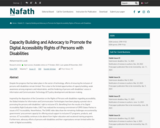
Despite the progress that has taken place in the sector of technology, efforts of ensuring the inclusion of persons with disabilities remain limited. This is due to the limited opportunities of capacity building, weak awareness among engineers and industrialists, and the hindering of persons with disabilities’ voices in Information and Communication Technology (ICT) policy development and decision-making.
Inspired by the disposition of the Convention on the Rights of Persons with disabilities regarding accessibility, the Global Initiative for Information and Communication Technologies have been playing a pivotal role in promoting the persons with disabilities’ right to inclusive ICTs. Benefiting from the results of its Digital Accessibility Right Evaluation Index, G3ICT has realized the increasing commitment of CRPD States Parties to issues of ICT Accessibility. Nevertheless, The DARE index data show the remaining challenges encountered by governments’ procurement capacity for offering actual support to inclusive ICT programs, products, and services. ICT accessibility continues to be absent from higher education and vocational training programs. Furthermore, advocacy efforts of persons with disabilities and their organizations remain limited within the realm of digital accessibility.
This paper discusses G3ICT’s Digital Accessibility Right Education (DARE) Academy, and its role in tackling issues of digital divide through offering a platform of educational development and advocacy capacity enhancement for persons with disabilities around issues of ICT accessibility.
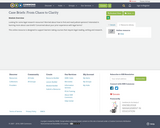
Looking for some legal research resources? Worried about how to find and read judicial opinions? Interested in learning more about case briefs? Concerned about your prior experience with legal terms?This online resource is designed to support learners taking courses that require legal reading, writing and research.

Lección virtual sobre las distintas categorías fundamentales de derechos humanos.
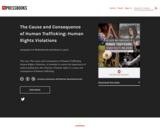
Short Description:
This text, The Cause and Consequence of Human Trafficking: Human Rights Violations, is intended to convey the importance of understanding how the violation of human rights is a cause and consequence of human trafficking.
Long Description:
This text, The Cause and Consequence of Human Trafficking: Human Rights Violations, is intended to convey the importance of understanding how the violation of human rights is a cause and consequence of human trafficking. In other words, human rights violations are egregious and they compound destitution. They deprive the man, woman and child of their basic humanity. Whenever any dimension of one’s humanity is deprived, it puts the person in a compromised state. Compromised states lead to some degree of impairment, distress or suffering. Impairment, distress or suffering leads to a disequilibrium in a person’s life. In an effort to quiet that compromised state, the individual may unknowingly make decisions that further compromises his or her state of being or result in human trafficking.
Word Count: 63892
(Note: This resource's metadata has been created automatically by reformatting and/or combining the information that the author initially provided as part of a bulk import process.)
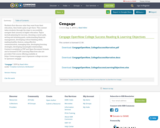
Students first discover what they want from their education, then build a plan to get there. This content takes students through the steps to successfully navigate their journey in higher education. Topics include planning for success, choosing a career path, setting and attaining goals, understanding financial management, developing critical thinking skills, making healthy choices, using effective communication, managing time, developing learning strategies, developing meaningful relationships. Content is available in PDF and Open Document formats and is licensed CC BY. Learning Objectives also are provided. Full course offering available at https://www.cengage.com/c/opennow-college-success-1e-opennow-cengage
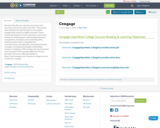
Students first discover what they want from their education, then build a plan to get there. This content takes students through the steps to successfully navigate their journey in higher education. Topics include planning for success, choosing a career path, setting and attaining goals, understanding financial management, developing critical thinking skills, making healthy choices, using effective communication, managing time, developing learning strategies, developing meaningful relationships. Content is available in PDF and Open Document formats and is licensed CC BY. Learning Objectives also are provided. Full course offering available at https://www.cengage.com/c/opennow-college-success-1e-opennow-cengage
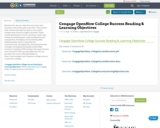
Students first discover what they want from their education, then build a plan to get there. This content takes students through the steps to successfully navigate their journey in higher education. Topics include planning for success, choosing a career path, setting and attaining goals, understanding financial management, developing critical thinking skills, making healthy choices, using effective communication, managing time, developing learning strategies, developing meaningful relationships. Content is available in PDF and Open Document formats and is licensed CC BY. Learning Objectives also are provided.

Word Count: 2109
(Note: This resource's metadata has been created automatically by reformatting and/or combining the information that the author initially provided as part of a bulk import process.)

Using Son of Citation/Citation Machine to cite photos found online

Textbook for POSC and CRJU 474
Word Count: 363016
(Note: This resource's metadata has been created automatically by reformatting and/or combining the information that the author initially provided as part of a bulk import process.)